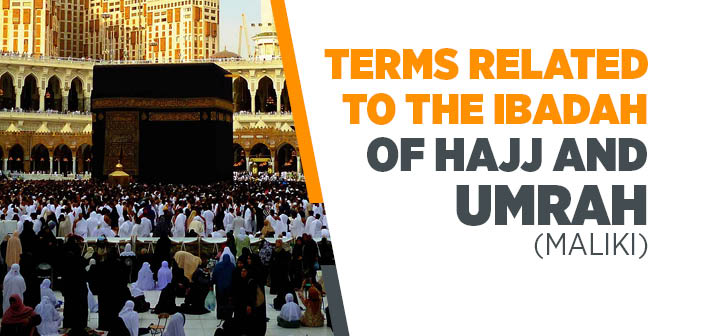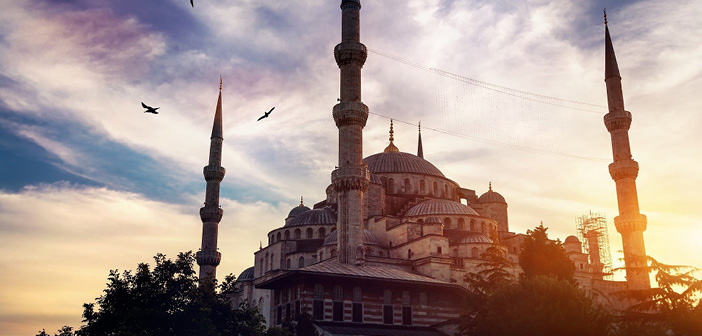What are the terms related to hajj and umrah? What is the glossary of hajj and umrah?
AFAKI: The hajjis that come from outside of the Miqat borders. The term means the one that comes from afar.
ARAFAT: The place where the wuquf is carried out, located 25kms south east of Makkah Mukarramah
HARAM AREA: Harem is the secure area in Makkah and its surroundings in where only Muslims are given permission to enter, with the condition that plants are not pulled out and animals are not harmed. The borders of the Haram areas have been made clear by Hazrat Muhammad with the guidance of Jibril.
HARWALA: When the sa’y is being carried out between Safa and Marwa, the fast paced and lofty walking, slight running, of men between the green pillars (and lights).
HILL AREA: They are the places between the Haram area and the Miqat places.
IHRAM: The person who makes intention to perform the hajj and umrah, making the actions and behaviour that is mubah in other times, haram to their nafs for a certain period of time, in other words until the rukuns of hajj and umrah have been completed.
IZAR: The cloth that men who wear the ihram wrap around the lower half of their body.
MANASIK: Actions and ibadahs that are related to hajj. Nusuk is the name for each one of the actions that are needed to be carried out at hajj and umrah, the ibadahs that are carried out.
MASJIDUL HARAM: It is the masjid that is around Beytullah (the Kabah). Masjidul haram is the most virtuous masjid of all masjids in the world. “One salat that is prayed at the Masjidul Haram is more virtuous than praying one hundred thousand salats at other masjids.”[1]
THE MIQAT AREA: It is the place where the ihram prohibitions start, it is the first place where preparation is carried out in order to come into the presence of Allah. It has been determined by Hazrat Muhammad, it is the five places where it is needed for people coming to Makkah to not pass without the ihram.
1. Zul Hulejfa: It is the miqat for people who are coming to Makkah through Madinah. It is 10km away from Madinah. It is 430 km away from Makkah. The most furthest miqat to Makkah is this one. Our Prophet p.b.u.h wore the ihram from this Miqat for the Hajjul Wada.
2.Juhfa: It is the miqat of the ones coming from the Egypt and Syria direction. It is 187kms from Makkah. People coming by way of the red sea from the Suvaysh direction, wear the ihram close to Juhfa around Rabig.
3.Zatuirk: It is the miqat of the ones coming from the Iraq direction. Its distance from Makkah is 94kms.
4.Qarnul Manazil: It is the miqat of those coming from the Najid and Kuwait direction. It is 96 kms from Makkah.
5.Yalamlam: It is the miqat of those coming from the Yemen and India direction. It is 54 kms from Makkah.
It is not wajib to wear the ihram for the person who passes through the miqats with an intention for trade, but does not intend to pass by Makkah.
MINA: The area that is between Makkah and Muzdalifa, found within the Haram borders. The place where the hajjis stone shaitan and cut the qurban.
MUHASSAR VALLEY: The place that separates Mina and Muzdalifa from one another and the place where the hajjis are not meant to stop at when they are going to Mina. This is the place where the Ashab Fil were destroyed (The army of the Yemen governor Abraha who came to destroy the Kabah).
MULTAZAM: A few stones on the Kabah Wall between the Kabah door and Hajarul Aswad.
MUZDALIFA: It is the place that is between Arafat and Mina within the Haram borders. It is wajib to be found for a period of time at Muzdalifa and make the wakfe on the first day of Eid Al-Adha from the time of imsaq up until the sun rises.
RAMAL: It is for men to run with short steps while shrugging their shoulders and walking loftily in the first three shawts (circuits) of the tawaf. The ramal is only sunnah for tawafs in where sa’y is going to be carried out afterwards.
RIDA: It is the stitchless cloth that men who wear the ihram wrap around the top half of their body (waist up).
RUKN YAMANI: It is the South corner on the Yemen side of the Kabah. This places is given salam to just like the Hajarul aswad.
TO SHAVE OR TRIM THE HAIR: To shave or trim the hair in order to get out of the ihram, after throwing stones at the Aqabah Jamrah, is of the wajibs of hajj and umrah. The time to shave or trim the hair at hajj is on the days of the slaughtering of the qurban.
It is wajib to carry out the duties when coming out of the ihram in this order; to first throw Stones at shaitan in Mina, then slaughter the qurban and then to have a shave.
SA’Y: To go from Safa to Marwa four times between the mountains of Safa and Marwa, and to come back from Marwa to Safa three times makes up seven shawts (circuits). This is the sa’y. This is of the wajib of hajj and umrah.
SHAWT: In tawaf, this is starting from the point of Hajarul aswad and walking all around the Kabah, then once again returning to the same point. As for sa’y, it is going once from Safa to Marwa or from Marwa to Safa. Every tawaf and sa’y consists of seven shawts.
STONING SHAITAN: Stoning shaitan, is throwing small stones on eid days at stone masses found in Mina that are called the small jamra, medium jamra and Aqabah jamrah.
On the first day of eid, only the Aqabah jamrah is stoned. This length of time continues up to the imsaq time on the second day of eid. With the throwing of the first stone the talbiye is cut off and the talbiya is not carried out after this. After stones are thrown at the Aqabah jamrah, the men are shaved and the ihram is gotten out of.
The time to throw stones is the four days of eid. On the second and third day of eid all three jamrahs are stoned. The waqt of the stoning on the second and third day of eid is from the time the sun is at its peak till the time of imsaq the next day. On the fourth day of eid the time of throwing stones will have come to an end with the setting of the sun.
The stones should be thrown at the jamrahs one by one with the hands, they should not be thrown all at once. The person who has enough strength is required to throw the stones themselves within a certain time frame.
It is sunnah to throw the seven stones back to back and say ‘’Bismillah! Allahu Akbar’’ when throwing each of them, to throw stones at first the small, then medium, then Aqabah jamrahs on the second and third days of eid and for the stones that are thrown to be small.
TAWAF: This is to go around the Kabah seven times by first starting from the Hajarul aswad and then moving forward by positioning the Kabah to the left side.
TAWAF QUDUM: It is the first tawaf that is carried out when Makkah Mukarramah is reached. It is sunnah for the Afakis (the ones that come from outside of Makkah).
TAWAF TATAWWU: It is the tawaf that those people found in Makkah Mukarramah carry out occasionally.
TAWAF UMRAH: The tawaf carried out by the one who makes intention for umrah.
TAWAF WADA: This means the Wada Tawaf. Its other name is Tawaf Sadr. It is the tawaf that must be carried out by the Afakis during the time of hajj, before leaving Makkah after the stoning of the jamras. The duties of hajj will end with this. This tawaf is not wajib for the people residing in the Makkah and haram area within the miqat borders and those who have just performed umrah. The women who have started menstruating before making the wada tawaf and women who could not clean themselves when leaving Makkah are not obliged to carry out the wada tawaf. Every tawaf that is made after the visitation tawaf is considered to be a wada tawaf.
TAWAF IFADA: It is the tawaf that is made on the days of Eid- Al-Adha, after getting off at Arafat. This is the tawaf that is the rukun of hajj. It is better for it to be made after coming out of the ihram and cleaning oneself.
TALBIYA: This is the talbiye dua that is frequently read during hajj when coming across a crowd, when going up somewhere high, when going down to a valley, when waking up from sleep and at the time of dawn:
Anlamı: ‘’Here I am O Allah, (in response to Your call), here I am. Here I am, You have no partner, here I am. Verily all praise, grace and sovereignty belong to You. You have no partner.’’
When the ihram has been worn and after two rakats of salat have been prayed, the ihram is brought until the tawaf starts and this is like the promise that was given in the bazmi alast, the day of creation of man.
TARWIYAH DAY: It is on the eighth day of Zul Hijjah. It is sunnah to go to Mina and spend the night there on this day.
UMRAH: The ibadah that is carried out on any day of the year. It is carried out by wearing the ihram, shaving or cutting the hair after the tawaf and sa’yee.
URANA VALLEY: It is the name of a valley in the plain of Arafat.
WAKFE: These are amongst the most important duties of hajj; to be found in Arafat on the day of Arafa, to be found in Muzdalifa after midnight on the night of eid, to make ibadah in these places such as making zikr for Allah such as talbiya, tasbih, takbir, to make repentance and recite duas, to be engaged in tafakkur and tazarru.
[1] Ibn Majah, hadith no: 1406
Source: Fiqh1 (According To The Maliki School Of Islamic Law), Erkam Publications





